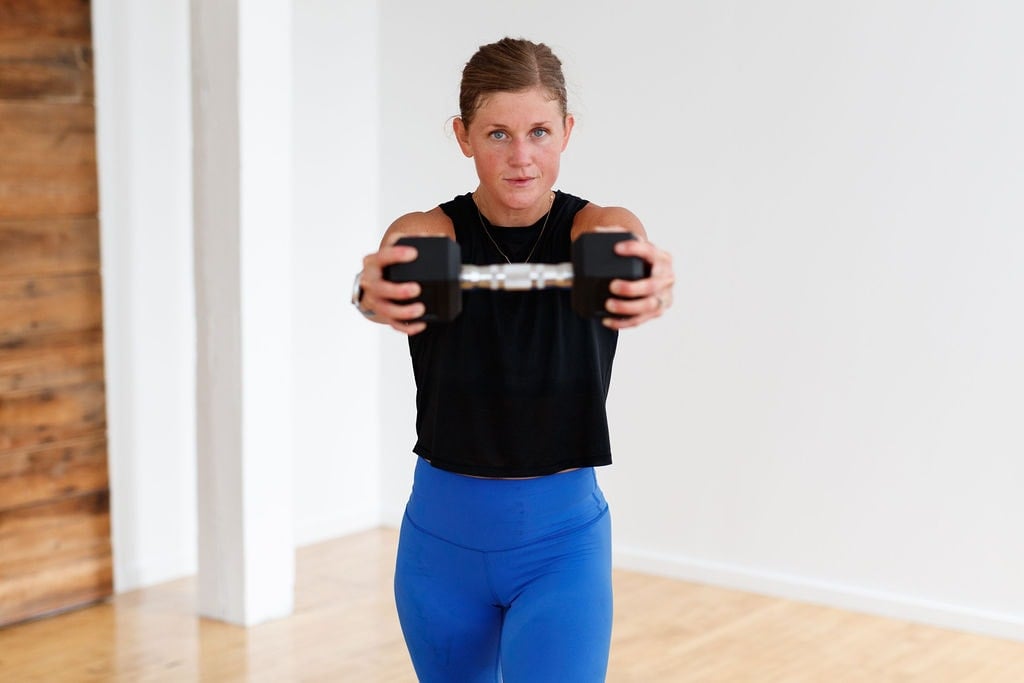Skip the boring cardio – these high-intensity exercises are more effective at building strength and burning calories. I love this fun and engaging “3-2-1” format – it combines compound dumbbell strength exercises with bodyweight core and cardio bursts. This effective combination allows us to get the benefits of core training, strength training and HIIT training at home, all in just 30 minutes.
As a personal trainer, one of the biggest mistakes I see people making when they want to increase muscle definition or lose weight is jumping on the treadmill or elliptical for hours.
Although steady-state cardio has its place, there are more efficient (and more fun!) ways to get fit at home. No gym membership, special equipment or hours of cardio needed.
In my opinion, HIIT, or high-intensity interval training, is so popular because it allows people to achieve significant fitness results in a short amount of time.
Alternating bursts of all-out effort with short periods of rest keeps our heart rates high for the entire workout, maximizing calorie-burn and increasing endurance.
STAY HYDRATED
Our Favorite Electrolytes
Our entire team uses and loves LMNT electrolytes! My favorite flavors are citrus and grapefruit, but they’re all so good. Use my link below for a FREE sample pack with any purchase so you can try ALL the flavors!
Free Sample Pack!
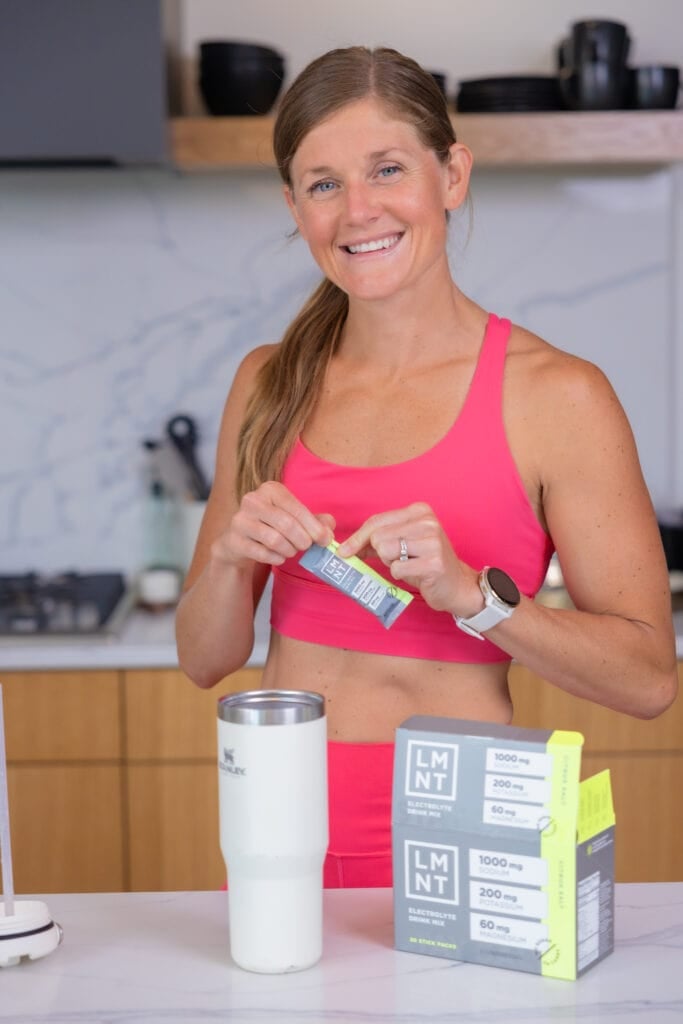
Today’s dumbbell HIIT workout includes a mix of high-intensity strength training exercises, cardio exercises and core exercises. Each type of workout has its own health benefits:
Strength Training: builds muscle mass and muscle definition, increases bone density, boosts metabolism, and improves athletic performance.
Cardio: improves cardiovascular health, reduces risk of heart disease and high blood pressure, supports healthy weight loss and weight management goals, releases stress and boosts mood.
Core: improves balance and stability, reduces lower back pain and reduces risk of injury.
Combining different types of training methods into one effective strength and HIIT workout allows us to reap the benefits of multiple training styles, making our workout more effective and efficient.
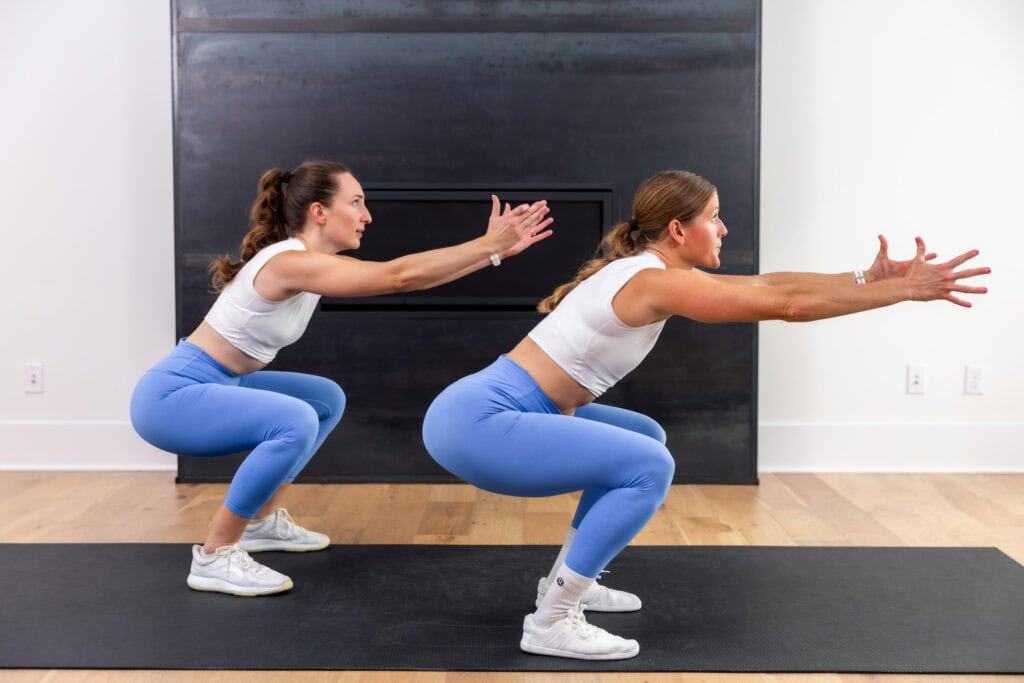
HIIT Training Workout (Build Muscle, Burn Fat)
Challenge yourself with this effective HIIT training at home workout, targeting every major muscle group in the body in under 30 minutes.
Add cardio HIIT sessions like this to your home workout plan one to two times per week to burn fat, increase cardiovascular capacity and increase endurance.
If you don’t have dumbbells available, you can substitute this no-equipment, low impact cardio workout.
Workout Instructions:
Follow along with the guided Strength and HIIT Training At Home Workout on YouTube, led by certified personal trainer, Lindsey Bomgren.
Your Workout Looks Like This:
3 Circuits (3 minutes strength, 2 minutes core, 1 minute cardio)
3 Exercises Per Circuit
Timed Intervals (time varies per circuit)
Complete All 3 Circuits, Then Repeat To Complete X3 Sets
Workout Equipment:
Medium Pair of Dumbbells. I recommend between 5-25 lbs depending on your fitness level. We used 15 and 20 lb dumbbells in today’s workout.
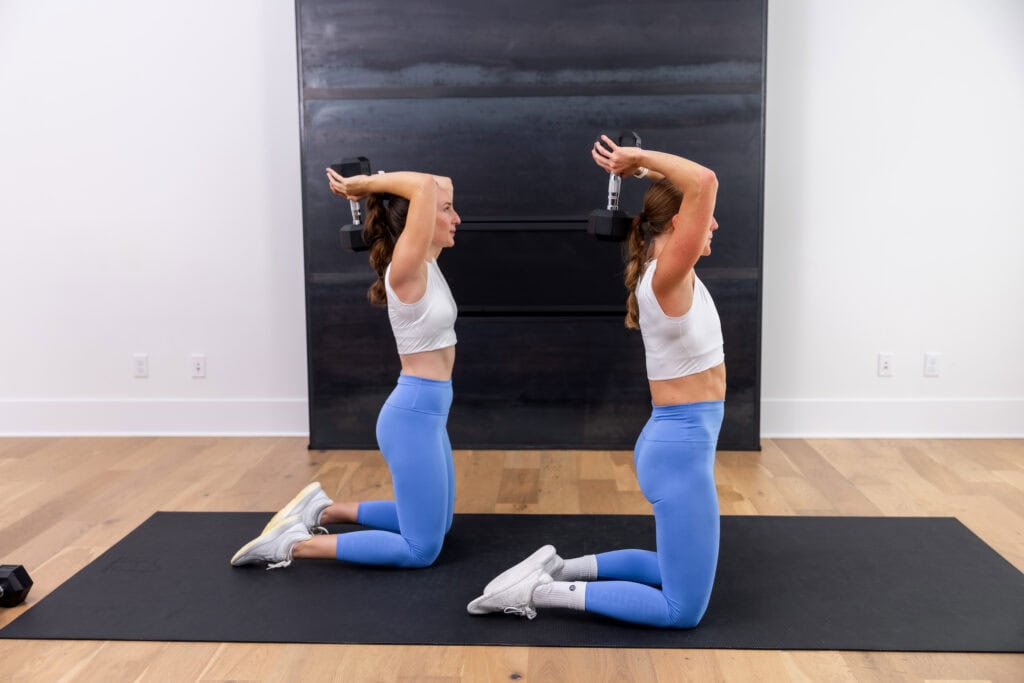
Workout Outline
CIRCUIT ONE
Deadlift Clean Squat
Curtsy Lunges
Glute-Biased Squats
CIRCUIT TWO
Reverse Crunch and Seated Twist
Flutter Kicks
Boat Pose Hold
CIRCUIT THREE
Burpees
Mountain Climbers
Squat Jumps
5 Best HIIT Exercises At Home
Deadlift, Clean and Squat
Targets: Lower body, glutes, hamstrings, hips, quads, calves, trapezius, deltoids, lower back, abs and core.
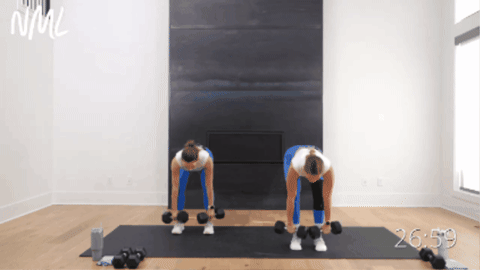
How To Do Deadlift Clean Squats
Start standing feet hip-distance apart and knees slightly bent. Hold a dumbbell in each hand in front of your thighs, palms facing in towards your body.
Hinge forward at the hips, pushing your hips back as you lower the dumbbells down along the front of your body. You should feel a stretch in the back of your legs (hamstrings). Focus on keeping your back in neutral alignment with your neck and shoulders throughout the entire movement. Keep a slight bend in your knees.
Then, drive through your heels to push your hips forward, squeezing your glutes as you return to a standing position.
As you press your hips forward to stand up, “clean” the dumbbells up towards your shoulders. Catch the dumbbells at your chest in a front rack position.
Then, bend your knees to lower down into a squat, pushing your knees out as you drop your hips parallel to your knees.
Drive through the heels to stand up, returning to starting position.
Modification: Omit the clean, alternating dumbbell deadlifts (RDLs) with dumbbell squats instead.
Reverse Crunch and Seated Twist
Targets: The lower abs and obliques. Also improves stability throughout the lower back, hips and spine.
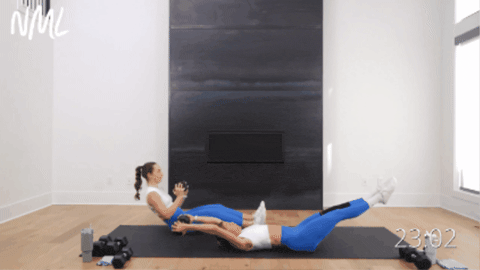
How To Do Reverse Crunches and Seated Russian Twists
Start lying on your back, core engaged, holding a single dumbbell horizontally between both hands. Extend your legs and arms away from each other, floating them off the mat.
Squeeze through your upper abs to lift your torso off the mat, crunching the dumbbell from overhead to your chest as you perform a sit up. At the same time, pull your knees in towards your chest, heels floating off the ground and knees bent.
Hold this seated position, keeping your torso straight and long, as you rotate your shoulders first to the right, twisting through the obliques to tap the ground outside your right hip with the dumbbell.
Return to center, then repeat on the left side, tapping the dumbbell to the ground outside your left hip before returning to center.
Then, slowly and with control, roll back to the mat and extend your arms and legs away from each other, returning to starting position.
Modification: Keep your heels on the ground for the oblique twists, and then sub a half crunch for the full reverse crunch.
Burpee
Targets: Upper body (chest, arms, back, shoulders), lower body (legs, glutes, hips) and core.
The burpee exercise is one of the most famous HIIT training moves for a reason. It’s an intense, full body movement, designed to push you towards your maximum heart rate quickly.
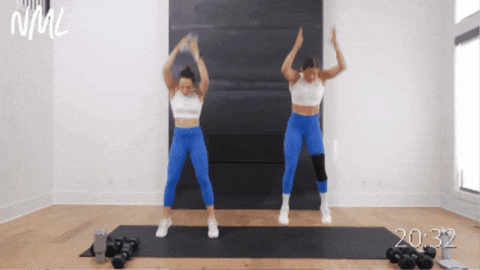
How To Do Burpees
Start standing, feet shoulder-width apart, arms at your sides.
Bend your knees and drop your hips as you lower into a squat position, then place your hands on the floor directly in front of your feet.
Shift your weight into your hands as you jump your feet back to softly land on the balls of your feet in a high plank position. Your body should form a straight line from your head to heels.
Elbows fall back towards your body as you lower your chest towards the ground, bringing your chest to meet the floor. Press back up and return to high plank.
Jump your feet up, landing outside your hands in a loaded squat position. Then drive through your legs to explode up, reaching arms overhead as you stand tall, returning to starting position.
Modification: Substitute towel slams for burpees. Or perform walking burpees, stepping your feet in and out of plank position rather than jumping.
Mountain Climber
Targets: Upper abs, lower abs, obliques, shoulders, glutes and thighs.
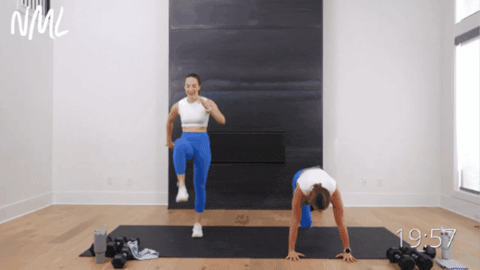
How To Do Mountain Climbers
Start in high plank position with your shoulders stacked over your wrists, weight evenly distributed amongst all ten fingers. Pull your kneecaps up towards your belly.
Hold this position, maintaining a straight line with your body, gaze slightly in front of you.
Then, drive your right knee towards your left elbow before quickly driving your left knee towards your right elbow.
Continue this pattern, alternating knee drives towards your chest at a rapid pace, as if “running” in a plank position.
Modification: Perform standing marches or knee drives.
Squat Jump
Targets: Legs, glutes, quads, hamstrings, outer glutes (side butt), inner thighs, calves and core.
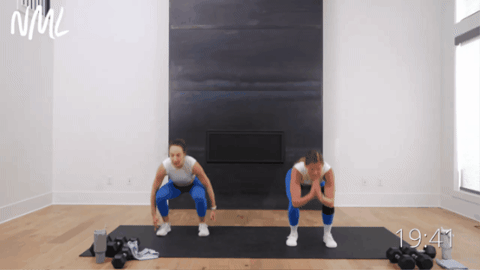
How To Do Jump Squats
Start in an athletic stance or loaded squat position, with your feet shoulder-width distance apart and a slight bend in your knees.
With your chest upright and your core engaged, lower your hips as if you were sitting back in a chair. Aim for 90-degree bends in both knees.
Then, explosively drive up, using the power in your legs and glutes to power into a standing position, feet leaving the ground.
Land softly with control, maintaining soft bends in both knees.
Modification: Omit the jump, performing air squats with a finger reach overhead.
FAQs
HIIT workouts, like any other form of exercise, are a form of stress. Cortisol is a hormone our bodies produce to handle stress, and isn’t inherently bad unless we produce too much of it too often. Current research indicates that high-intensity workouts result in an immediate cortisol spike, but that cortisol levels decrease and return to the baseline after 24 hours (Harvard Health).
I program my workouts to be complete training sessions – that means you don’t need to do any additional workouts in addition to the ones programmed in our workout plans. That said, I do recommend aiming for 8-10k steps a day – staying active throughout the day is one of the best ways to increase overall calorie burn, leading to weight loss.
Although it’s normal to feel some soreness after a workout, it’s not necessary for muscle growth. Muscle soreness, or DOMS (delayed-onset muscle soreness) usually occurs 1–2 days after exercise. You can reduce muscle soreness by prioritizing active recovery exercises, stretching, foam rolling, and epsom salt baths.
No More Boring Cardio, Pin These At Home HIIT Exercises
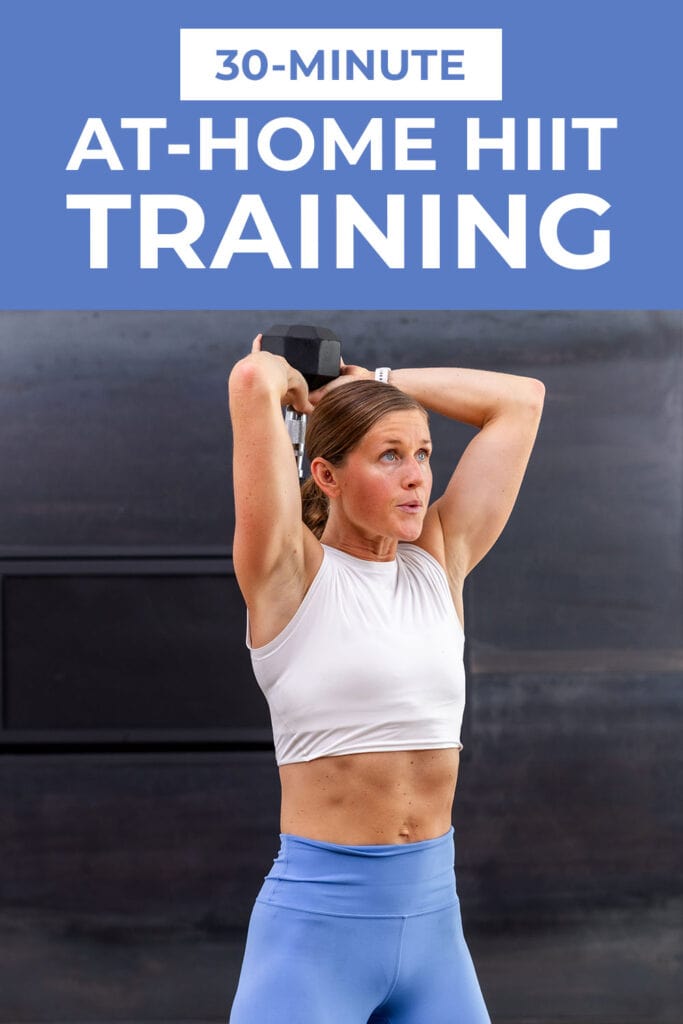
This post includes affiliate links. I do earn a commission for products purchased using these links (at no additional cost to you). Thank you for supporting Nourish Move Love, making the content you see on this blog possible.

